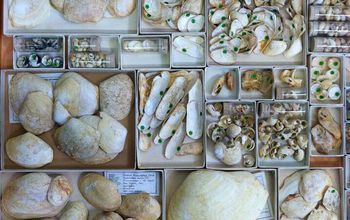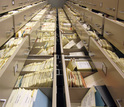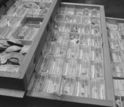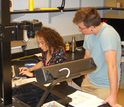Hola amigos. A VUELO DE UN QUINDE EL BLOG., hemos recibido información de la Fundación Nacional de Ciencias de Los Estados Unidos, sobre los premios a la subvenciones para mejorar la calidad de las colecciones de la biodiversidad en América.
More information...
http://www.nsf.gov/news/news_summ.jsp?cntn_id=136007&WT.mc_id=USNSF_51&WT.mc_ev=click
 Credit and Larger Version |
Slime molds, smut fungi, powdery mildew: These are
some of the millions of microfungi documented in biological institutions
across America.
These ubiquitous microscopic organisms play
important ecological and environmental roles, yet little is known about
their distribution or biology. But what if we could digitize and
combine those disparate microfungi documents, creating a rich trove of
data for researchers to explore?
That's the goal of the Microfungi Collections Consortium, one of the latest projects funded through the National
Science Foundation's (NSF) Advancing Digitization of Biodiversity
Collections (ADBC) program. ADBC expands and enhances America's
biodiversity collections, providing greater access to centuries of
discovery that document the diversity of life on Earth.
ADBC projects support more
efficient, innovative ways to access biological and paleontological
research collections. Data for millions of biological specimens are
digitized and added to the National Resource for Digitization of
Biological Collections (iDigBio), accessible to scientists, educators and the public.
This is the fifth round of ADBC projects: seven awards, totaling more than $5.8 million and incorporating the efforts of scientists from nearly 50 institutions across the United States.
"Biological diversity is critical to the future of our planet, yet
records of that biodiversity are often stored in private collections,
inaccessible to scientists and the public," said James Deshler, a
division director in NSF's Biological Sciences
Directorate, which funds the ADBC program. "ADBC takes this data and
stores it for the world to see, from the smallest collections started by
one passionate scientist to collections with tens of thousands of
specimens. The program is structured to allow a maximum diversity of
scientists and institution types to work together."
ADBC funds two types of projects: Thematic Collections Networks (TCNs), and Partners to Existing Networks (PEN).
TCNs focus on "grand challenge" questions in biodiversity, and
facilitate research opportunities as data becomes increasingly
available. Two TCNs were awarded in this ADBC round. The Microfungi Collections Consortium
brings together 38 institutions in 31 states to digitize their
microfungi records, spurring new research and insights into these
important organisms. The Consortium will digitize specimen descriptions,
illustrations and annotation notes for more than 1.2 million North American microfungi specimens. The principal investigator on the award is Andrew Miller of the University of Illinois at Urbana-Champaign.
The second TCN focuses on the fossil record of marine invertebrate
communities in the Eastern Pacific. Starting from the Cenozoic
period--which began about 66 million years ago, shortly after the
extinction of the dinosaurs--this fossil record is especially rich. Yet
most specimens aren't digitized, and are therefore unavailable for
large, coordinated study.
This TCN--a partnership of seven primary institutions and one federal
agency, the Smithsonian Institution--will capture this fossil record,
providing invaluable data for understanding how organisms responded to
ecological and environmental changes: knowledge to help scientists
better understand and predict how today's marine biodiversity might be
impacted by climate change. The principal investigator on the award is Charles Marshall of the University of California, Berkeley.
Both TCNs also provide graduate and undergraduate training opportunities, and outreach to K-12 educators, students and the public.
PEN awards allow institutions that were not fully ready to
participate in the initial TCN to add their collections. Details on the
five funded PEN awards are below:
- About 8,000 macrofungi specimens from the University of Maine's Richard Homola Mycological Collection will be added to the existing Macrofungi Collection Consortium. The consortium is working to understand the diversity of macrofungi--like their smaller cousins, the microfungi, they play important ecological and environmental roles. The principal investigator (PI) is Seanna Annis at the University of Maine.
- Images and specimen data from nearly 5,000 Cenozoic insects, from the University of California Museum of Paleontology, will be added to the existing Fossil Insect TCN; data that will help scientists understand how these climate-sensitive organisms responded to abrupt environmental changes. The PI is Diane Erwin of the University of California, Berkeley.
- Two PEN awards will add data to the existing New England Vascular Plant Network, which works to understand climate and land use change across New England. One award supports the addition of about 55,000 plant specimens--collected over the past 170 years--from the University of Maine Herbarium. The PI is Christopher Campbell from the University of Maine. The second award supports the addition of about 150,000 specimens from the New York Botanical Garden, and the PI is the Garden's Barbara Thiers.
- Darkling beetles and ground beetles may not look all that impressive, but they are important indicators of environmental changes. About 80,000 of these beetle specimens--collected over the past 70 years by Ohio State University researchers--will be added to the Southwestern Collections of Arthropods Network. This addition will more than double the available data for these two beetle groups, enhancing scientist's ability to assess environmental changes and biological diversity. The PI on the award is Norman Johnson of The Ohio State University.
-NSF-
Media Contacts
Jessica Arriens, NSF, (703) 292-2243, jarriens@nsf.gov
The National Science Foundation (NSF) is an independent federal agency that supports fundamental research and education
across all fields of science and engineering. In fiscal year (FY) 2015,
its budget is $7.3 billion. NSF funds reach all 50 states through
grants to nearly 2,000 colleges, universities and other institutions.
Each year, NSF receives about 48,000 competitive proposals for funding, and makes about 11,000 new funding awards. NSF also awards about $626 million in professional and service contracts yearly.
Useful NSF Web Sites:
NSF Home Page: http://www.nsf.gov
NSF News: http://www.nsf.gov/news/
For the News Media: http://www.nsf.gov/news/newsroom.jsp
Science and Engineering Statistics: http://www.nsf.gov/statistics/
Awards Searches: http://www.nsf.gov/awardsearch/
NSF Home Page: http://www.nsf.gov
NSF News: http://www.nsf.gov/news/
For the News Media: http://www.nsf.gov/news/newsroom.jsp
Science and Engineering Statistics: http://www.nsf.gov/statistics/
Awards Searches: http://www.nsf.gov/awardsearch/
|
|||||||
| The National Science Foundation (NSF) | |
||||||
ayabaca@gmail.com
ayabaca@hotmail.com
ayabaca@yahoo.com
Inscríbete en el Foro del blog y participa : A Vuelo De Un Quinde - El Foro!




No hay comentarios:
Publicar un comentario